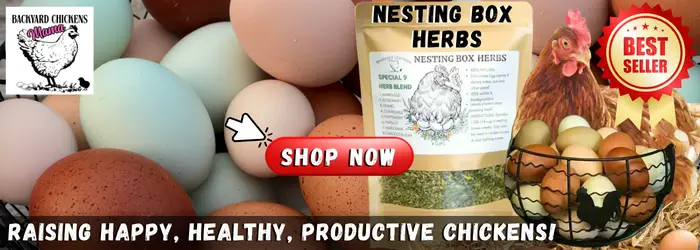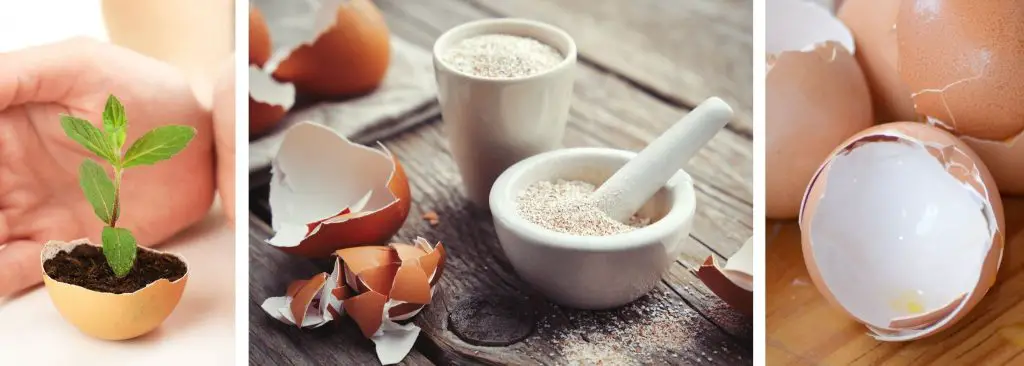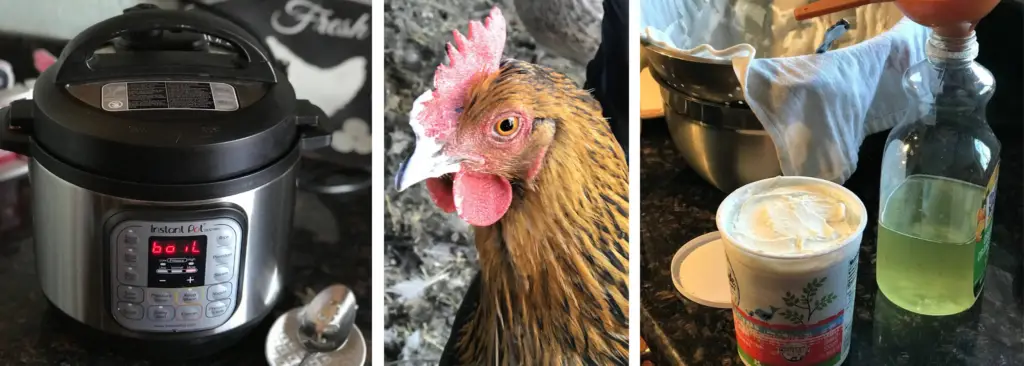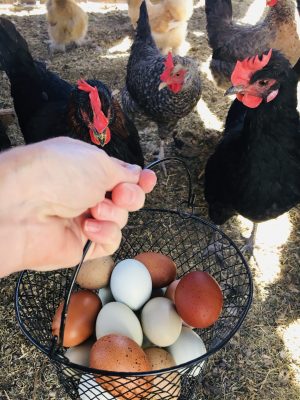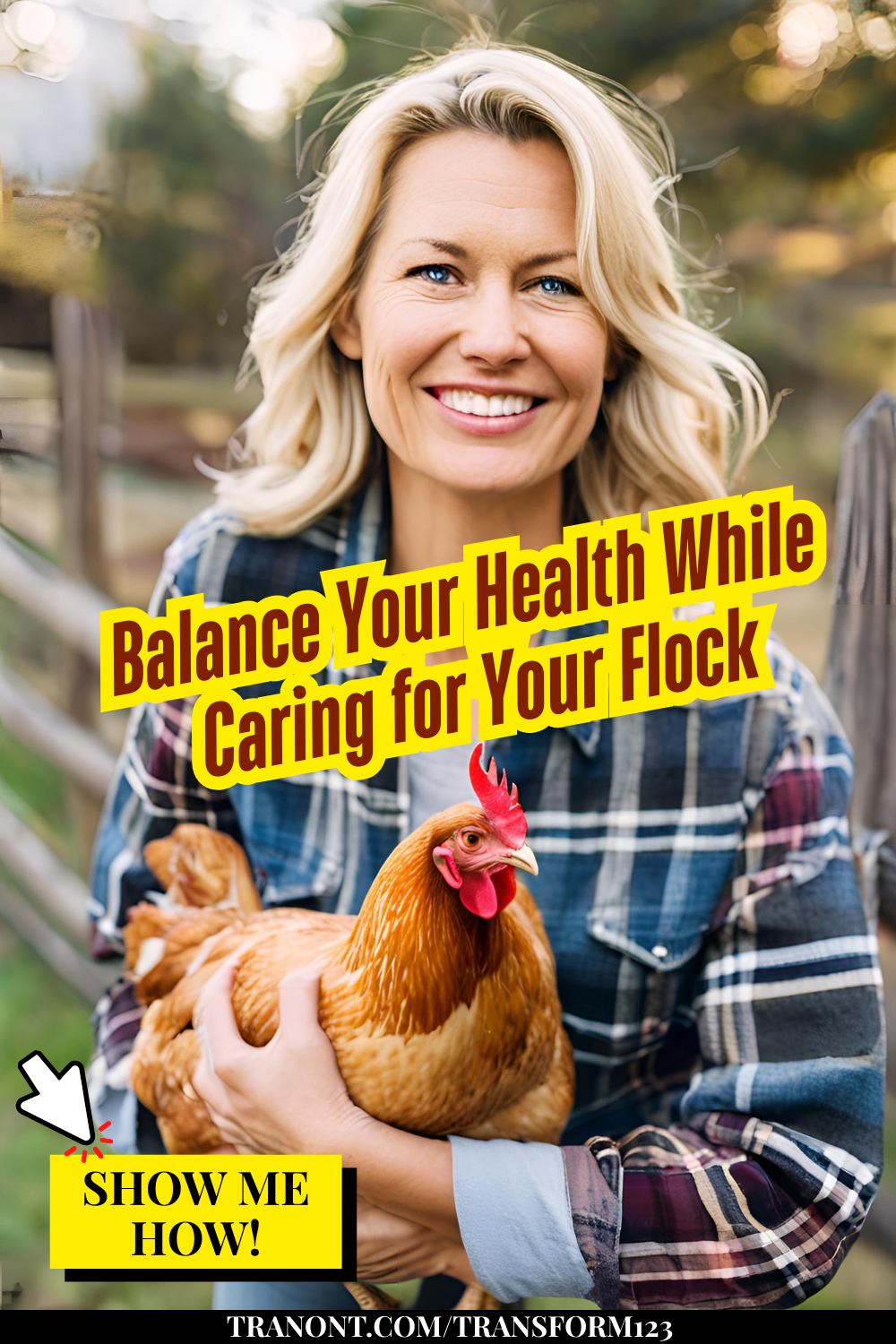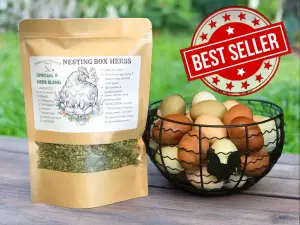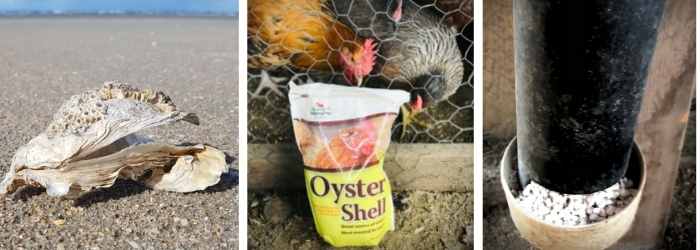
“Do my chickens need oyster shell?” Laying hens need increased calcium, such as oyster shell, in their diet. Older hens that are not laying and roosters do no need oyster shell. Laying hens need 4 x as much calcium because the eggs that they produce are made up of mostly calcium!
1. How Much Oyster Shell Should I Give My Chickens?
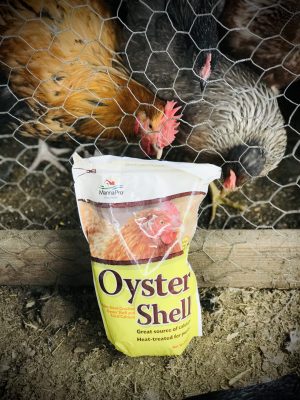
Oyster shell is a calcium supplement that should be offered on the side for your laying hens. This should be available at all times as they will only eat as much as they need. Don’t worry, your roosters and non-laying hens will leave it alone.
A hen needs about 4 grams of calcium a day to produce an egg that contains 2 grams of calcium.
Hens instinctively know how much calcium their body needs to be healthy and produce good quality eggs. Just leave a bowl of oyster shell out on the side and let her regulate how much she needs.
Hens that are not offered enough calcium can develop rickets and soft bones.
Even when she is going through a molt or taking a break from laying during the cold winter months, it should still be available.
By having it available during off laying times, it will help to strengthen her bones and better prepare her for producing healthy, thick shelled eggs when she starts laying again.
Can chickens eat too much oyster shell?
Yes, chickens can eat too much oyster shell if it is mixed in with their regular chicken feed. It should never be mixed in with their laying pellets.
Hens that are given oyster shells mixed in with their regular feed are more likely to inadvertently eat too much of the oyster shell, also resulting in rickets and soft bones.
Offer all calcium supplements on the side and let your hens regulate how much they need.
2. When Should I Give Chickens Oyster Shells?

Oyster shell should be offered as soon as the first hen in your flock begins to lay. Not all of your hens will begin laying at the same time, but it is safe to leave it out. Your chickens will only eat the oyster shell if their body requires it.
Roosters and younger chicks don’t require any added calcium in their diet, so they will instinctively just leave it alone.
If you notice one of your hens that hasn’t started laying yet begin to eat some oyster shell, this is a sign that she will begin laying very soon!
3. Does Oyster Shell Help Chickens Lay Eggs?
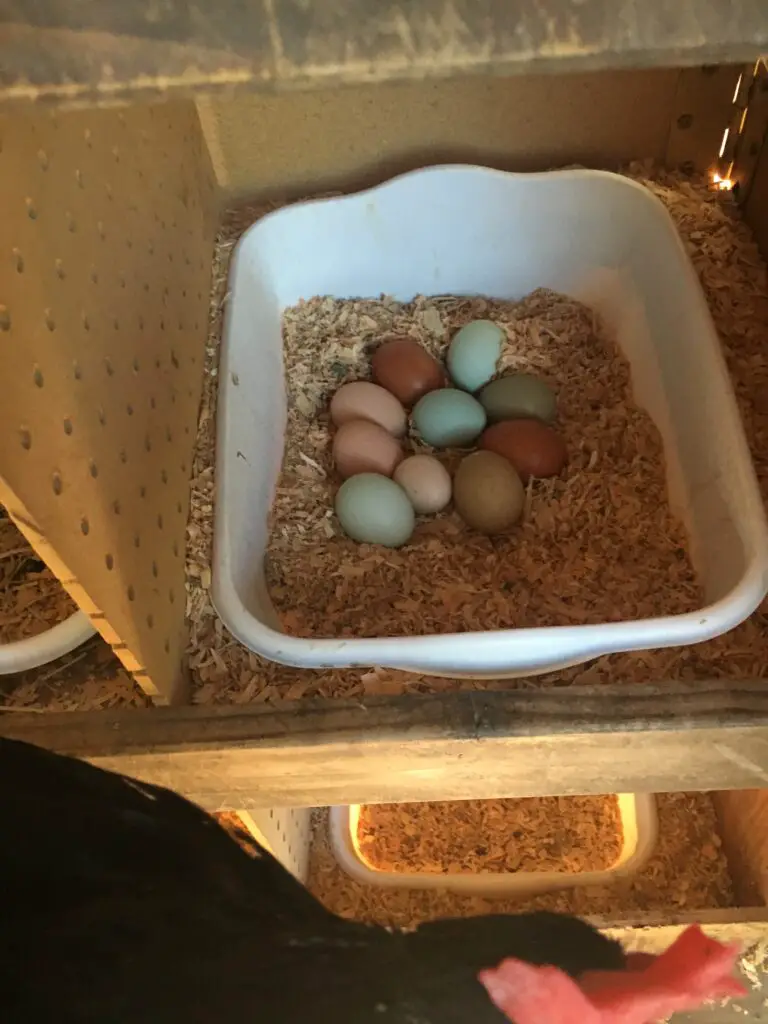
Oyster shell, along with a layers feed containing increased calcium, does help chickens the ability to produce an optimal amount of eggs for their breed. Not only will they lay more, but their eggs will be of higher quality too; larger eggs, thicker egg shells.
Hens with insufficient calcium (not provided oyster shell and laying pellets) are likely to produce less eggs and eggs of lower quality; smaller eggs, thinner egg shells, eggs without shells.
4. Other Ways to Supply Your Backyard Chickens With Calcium
Feed Egg Shells Back to Your Chickens
Don’t throw away your egg shells! Egg shells are nutrient rich with calcium and make a wonderful calcium supplement for your laying hens.
I have a little basket that I set next to my stove top that I put my egg shells into. Once I save up enough egg shells, I prepare them before giving them to my laying hens.
How to Prepare Egg Shells Before Feeding them Back to Your Chickens
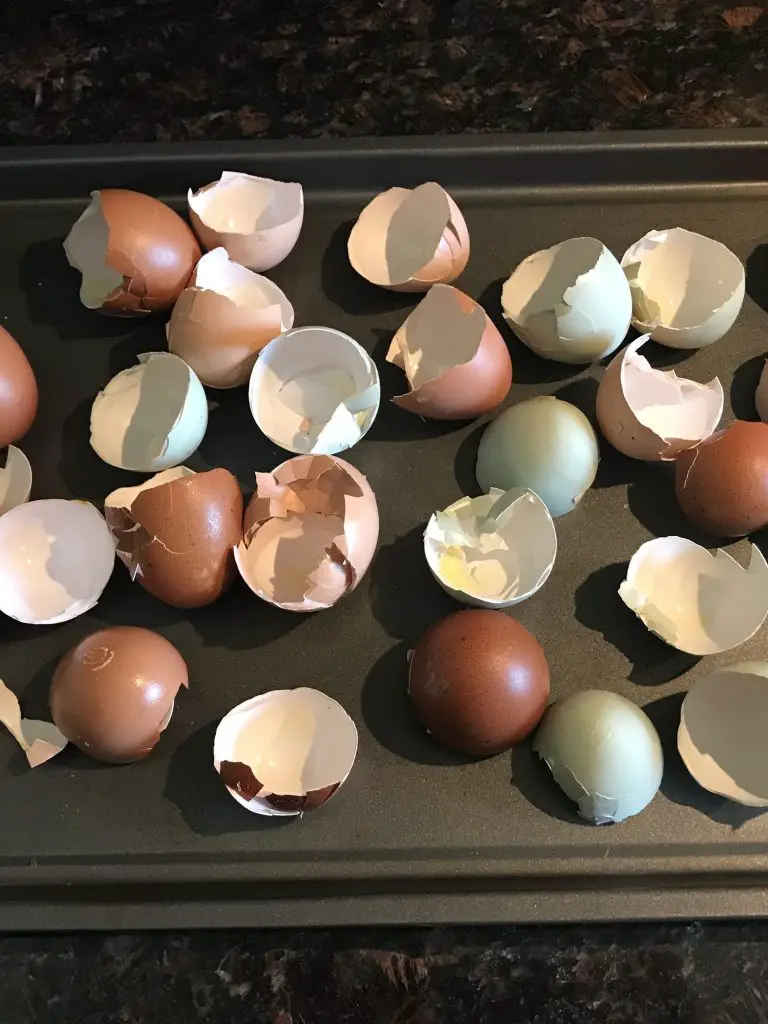
- Rinse the egg shells before placing them into your storage basket.
- Once you have saved up enough egg shells, it’s time to prepare them in order to feed them back to your laying hens.
- Preheat your oven to 350℉.
- Line a cookie tray with a single layer of egg shells.
- Cook the eggshells in your oven for 10 minutes to kill any harmful bacteria that the egg shells have on them.
- Egg shells will be very HOT! Let them cool down before crushing.
- Place the egg shells into a bowl and use the bottom of a flat glass to crush them.
- I like to crush them down into tiny pieces so my chickens don’t recognize them as egg shells!
- Place your crushed egg shells in a separate serving container and let your girls eat it as needed.
1 egg shell contains about 2 grams of calcium. The average laying hen requires between 4-5 grams of calcium per day.
Feed Limestone to Chickens
Limestone is an alternative that you can offer to your laying hens on the side. It can be offered exactly the same way as you would offer oyster shell. The only difference is that limestone contains 33.3% calcium and oyster shell contains 34.3% calcium.
Lactose Free Instant Pot Yogurt for Chickens
Yogurt is also high in calcium and makes a great treat for your chickens. I like to serve my chickens Lactose free Instant Pot yogurt. They absolutely LOVE it. But stand clear when you serve it to them. They tend to fling it all over when they are eating!
“Chickens are NOT lactose intolerant. Chickens do produce a small amount of lactase which does not make them lactose intolerant. This is why they are ok consuming a small amount of products containing lactose without any harmful effects.”
How to Make Homemade Instant Pot Yogurt for Chickens
5. Where to Get Free Oyster Shells
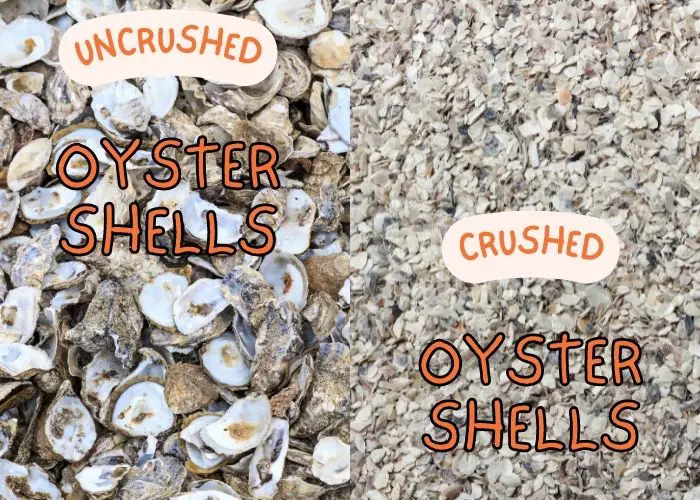
Ask Restaurants for Oyster Shells
Seafood restaurants and Sushi Bars/Restaurants may be willing to save up a bag of oyster shells for you. It can’t hurt asking.
Most restaurants throw these shells away daily!
Some restaurants boil and reuse their oyster shells, but throw away only the chipped ones. Let them know that you will take the broken ones. You are going to crush them all anyway.
Gather Oyster Shells from the Ocean Shores
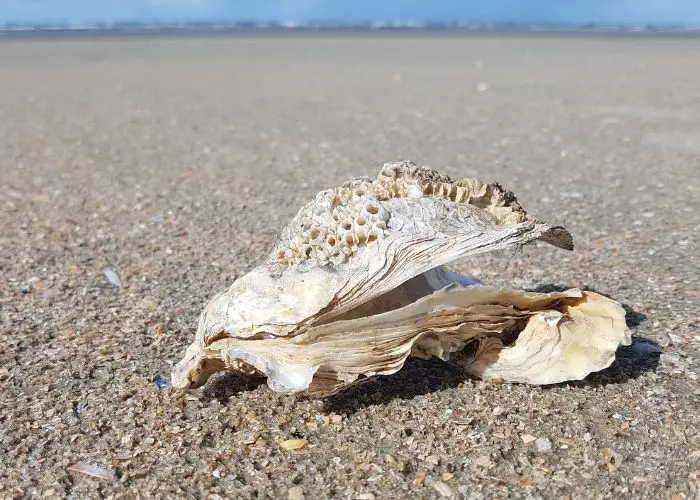
Depending upon which beach, you can gather oyster shells from your very own ocean shores. Find out what the local laws are where you would like to gather.
Many local beaches allow the gathering of sea shells, as long as the shells are not inhabited with any sea life. Some places have a “bag limit” as to how many you can collect at one time.
Check first before you gather.
How to Prepare Oyster Shells Before Giving them to Your Chickens
In order to remove any bacteria and mold from the clam shells, it is important to bake them prior to crushing and serving to your hens.
- Preheat oven to 350℉.
- Line a baking pan with a single layer of oyster shells.
- Bake for 10 minutes.
- Remove from oven and let the shells completely cool.
- Place them into an empty feed bag or burlap sack.
- It is advisable to wear goggles to protect your eyes for the next step.
- Hold the bag closed with one hand and use a hammer with your other hand to crush the oyster shells through the bag.
- Once the oyster shells are broken up into small enough pieces, it can be offered to your hens by placing it into a separate container beside their food.
- Your laying hens will eat as much of it as their bodies require to produce
- Offer crushed oyster shell all year round. Laying hens will naturally cut back on how much oyster shells they eat during non-laying times.
CONCLUSION: Do My Chickens Need Oyster Shell? 5 Important Tips
- Laying hens need to be offered crushed oyster shell or some sort of a calcium supplement.
- It should always be available as they will only eat as much as their body requires.
- By providing oyster shells for your laying hens, it will encourage them not only to lay more, but they will also produce eggs of much better quality (Larger eggs, thicker egg shells).
- You can always buy crushed oyster shell at your local feed store. Places that you can get raw oyster shell are at seafood restaurants, sushi bars and ocean shores.
- Bake raw oyster shells for 10 minutes at 350℉ before crushing and offering to your laying hens.
